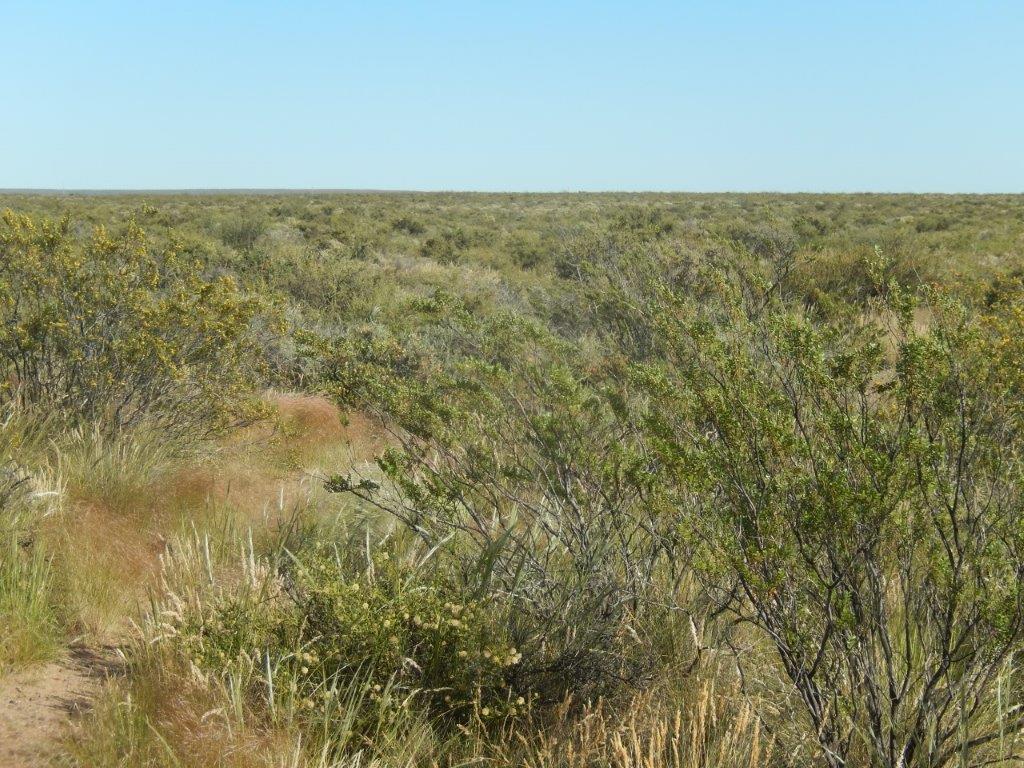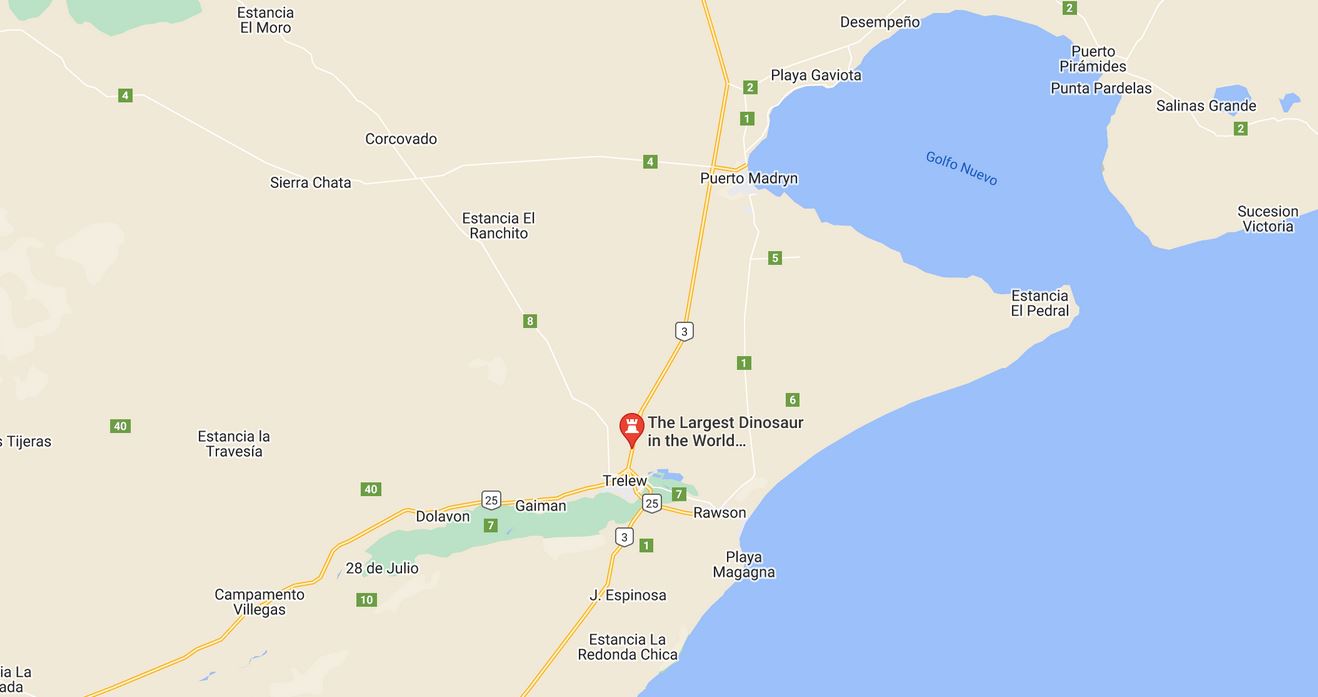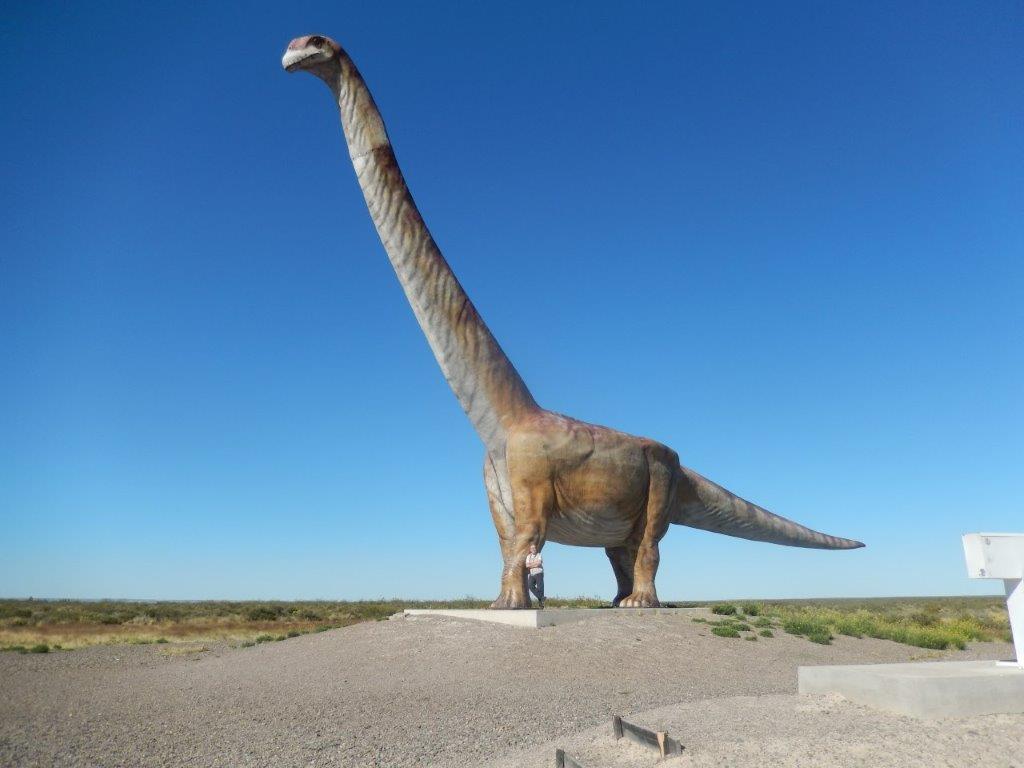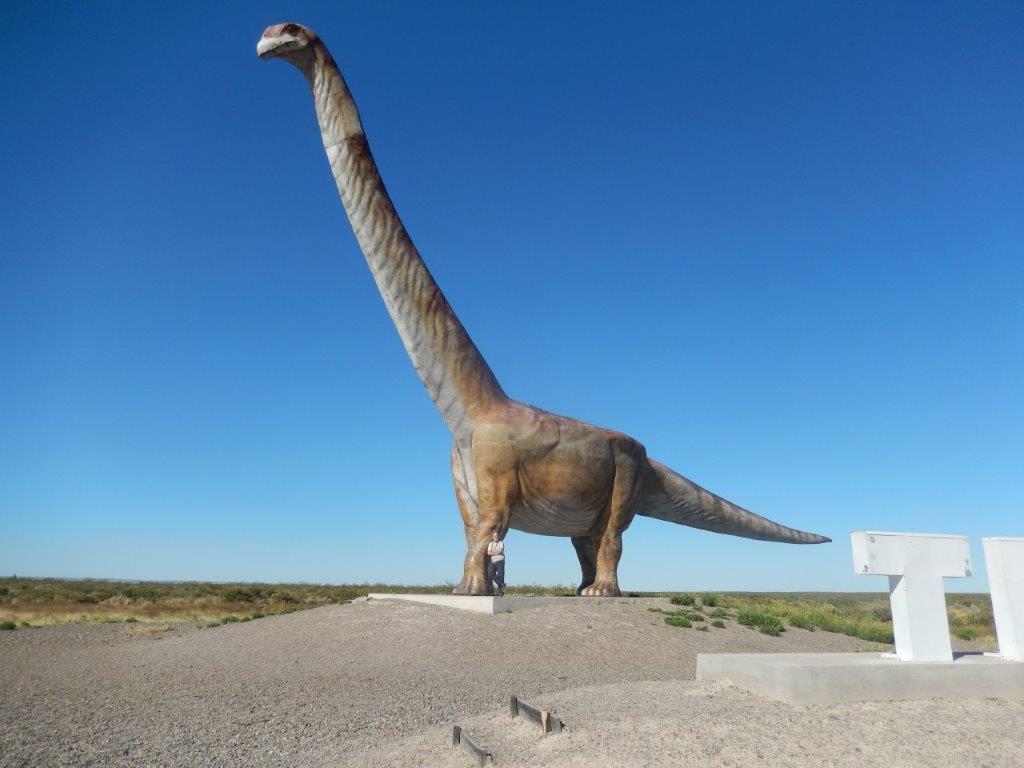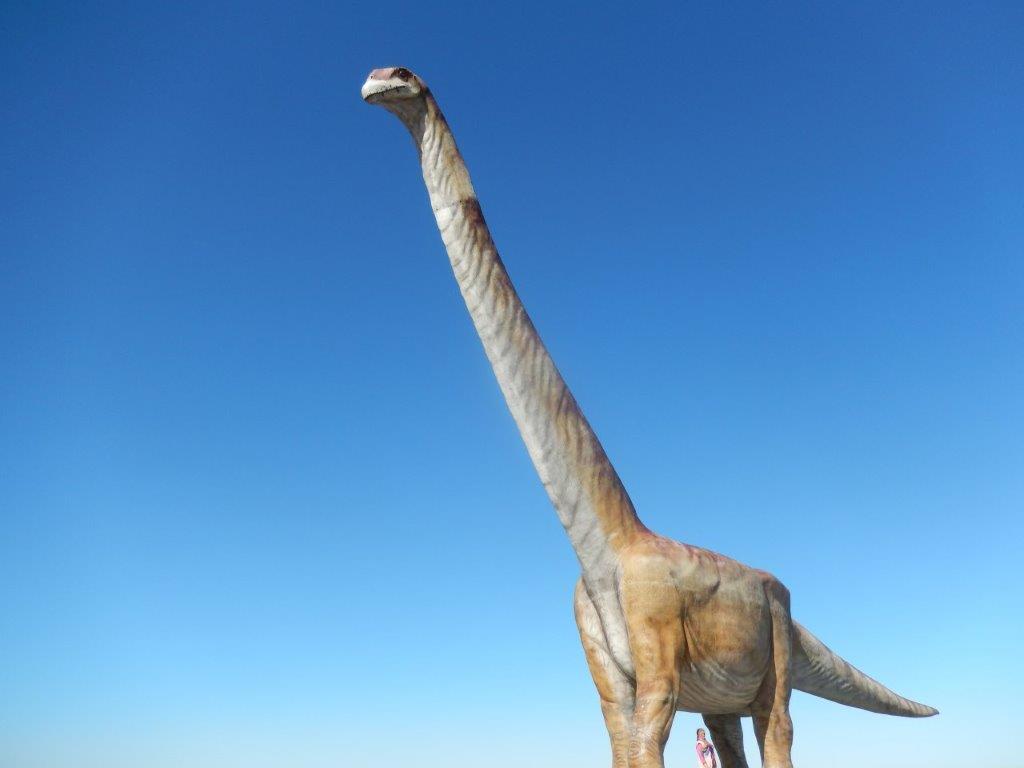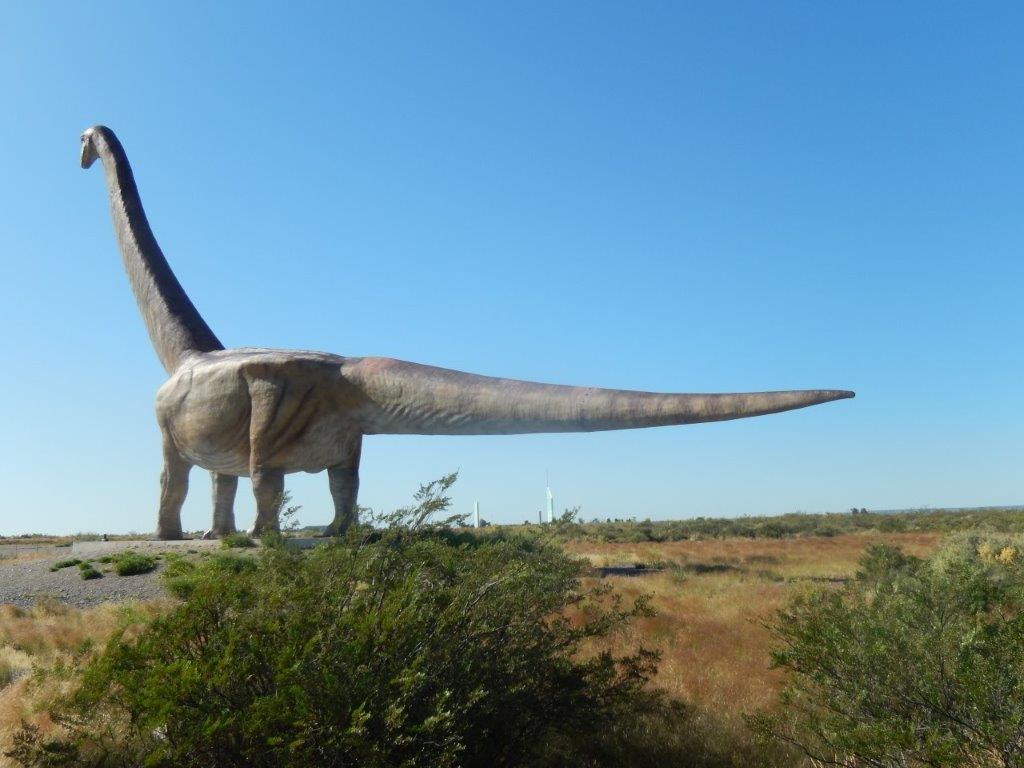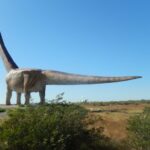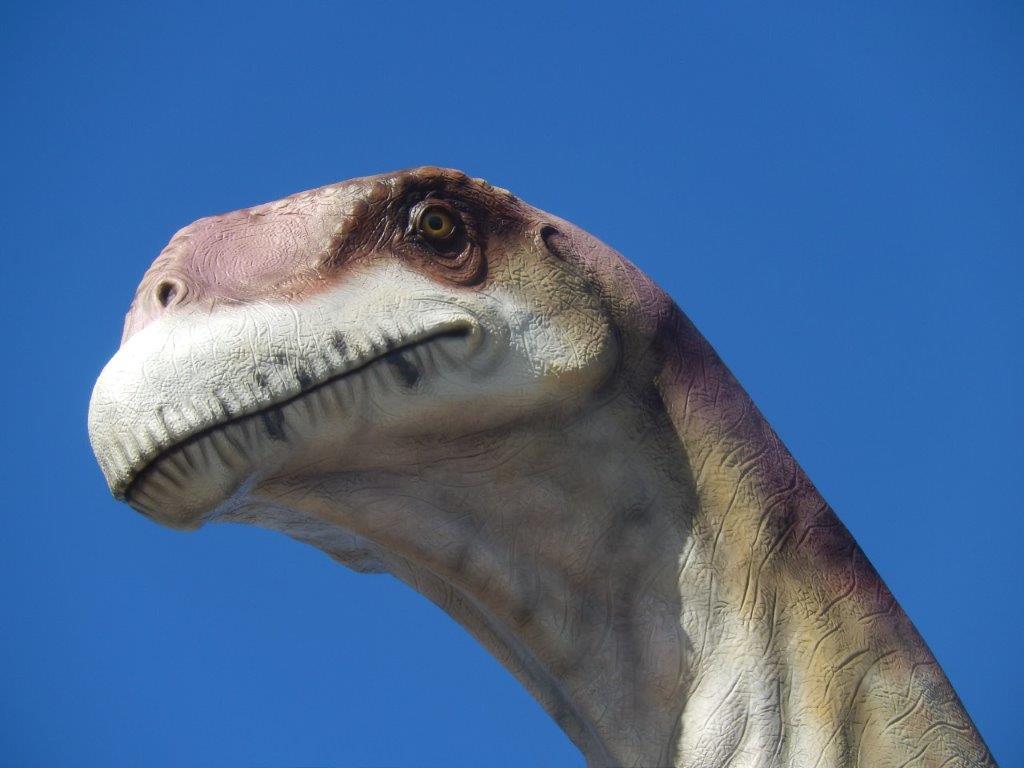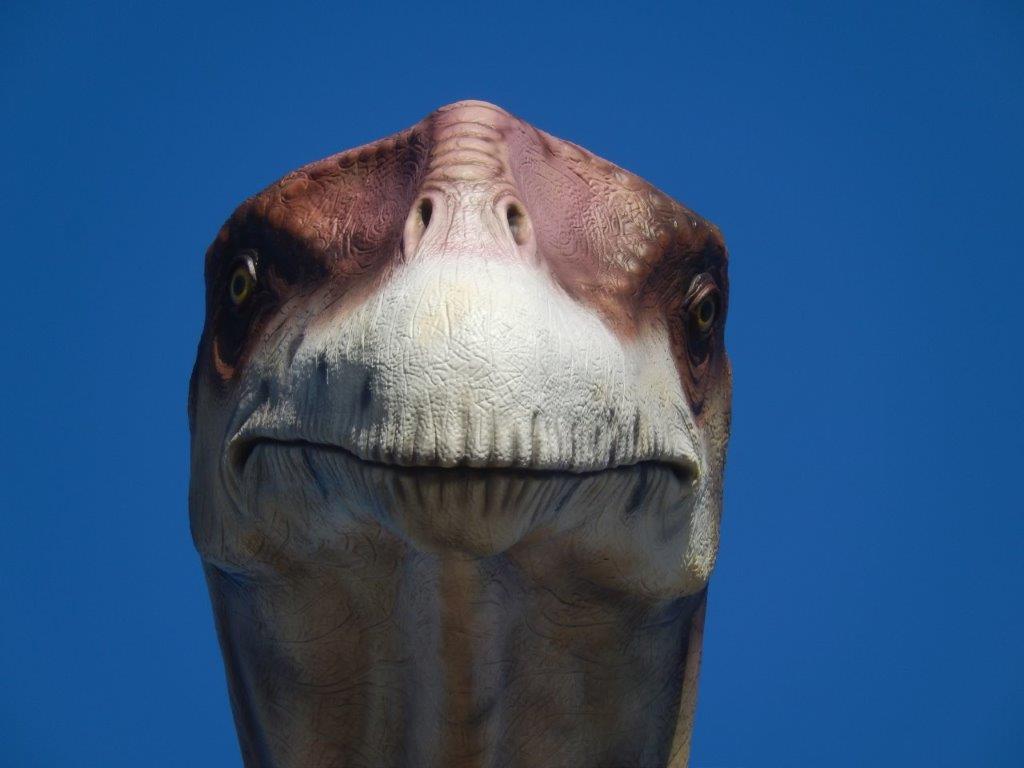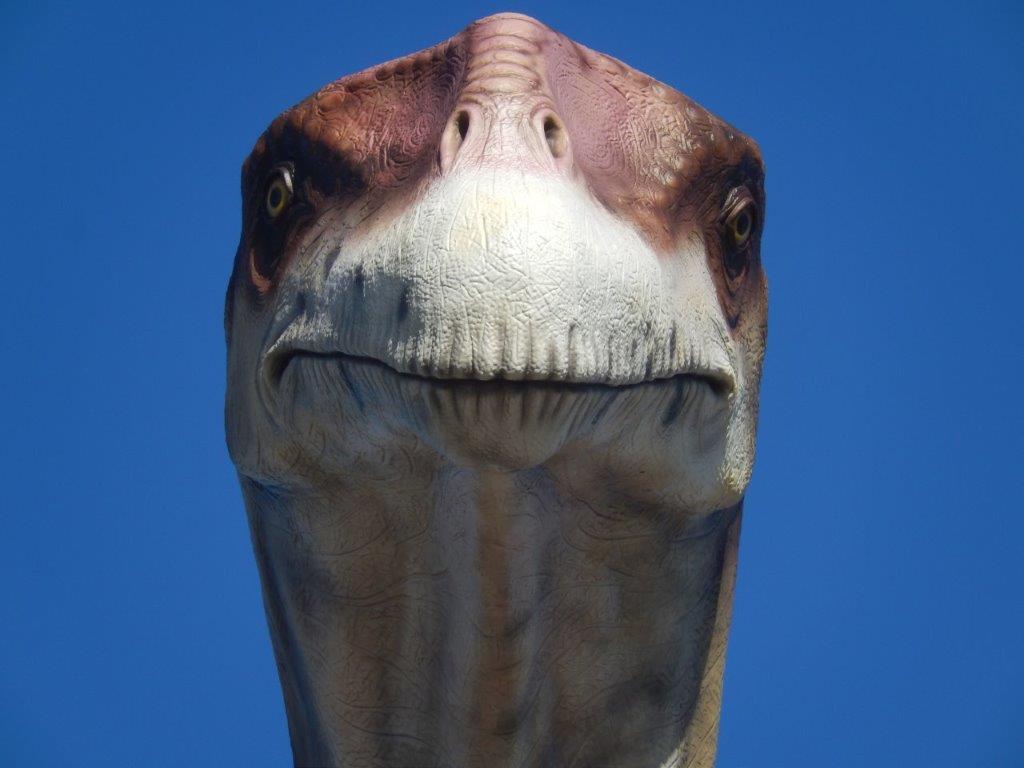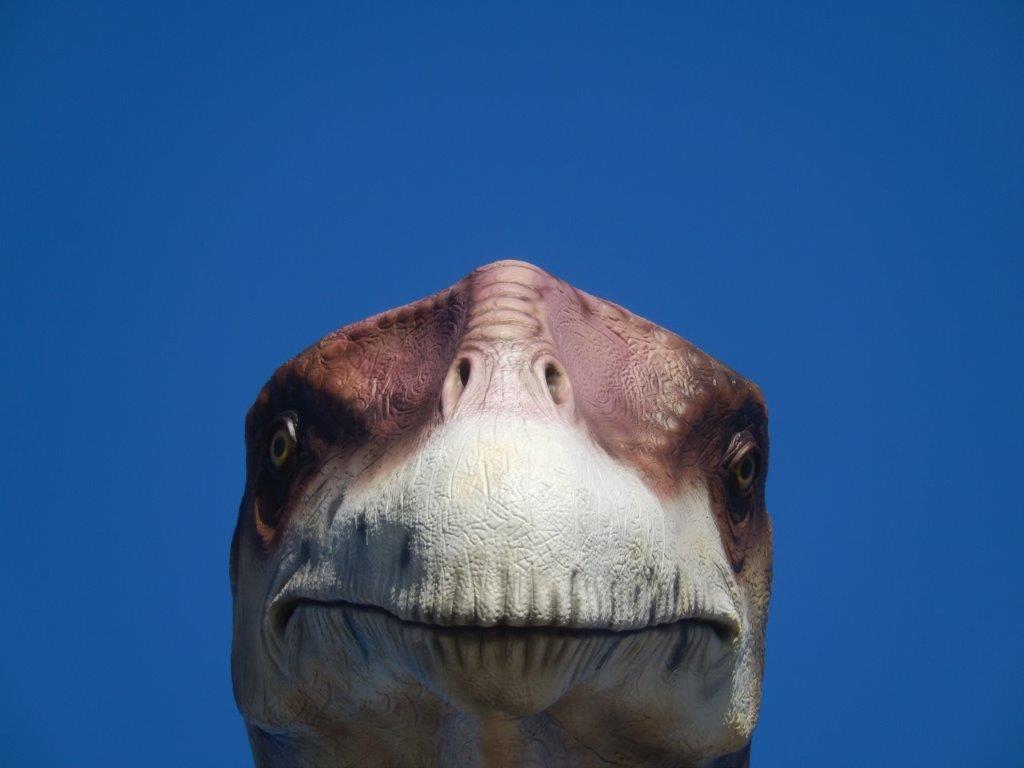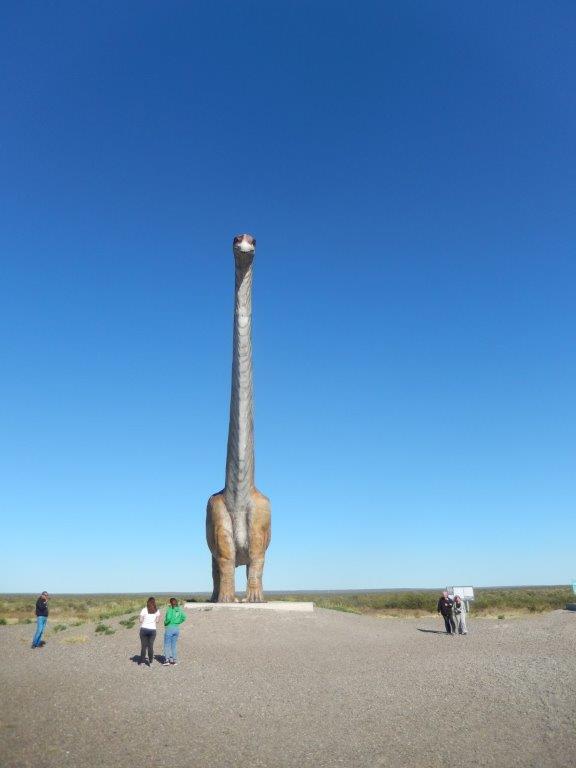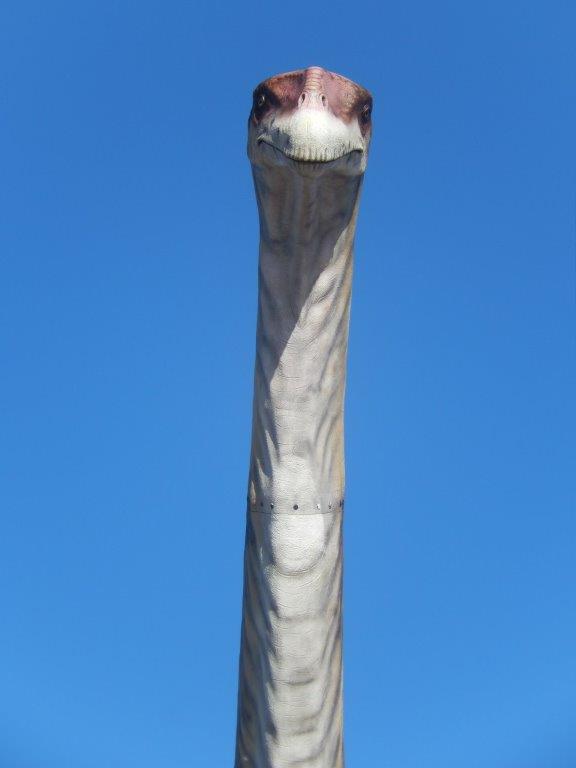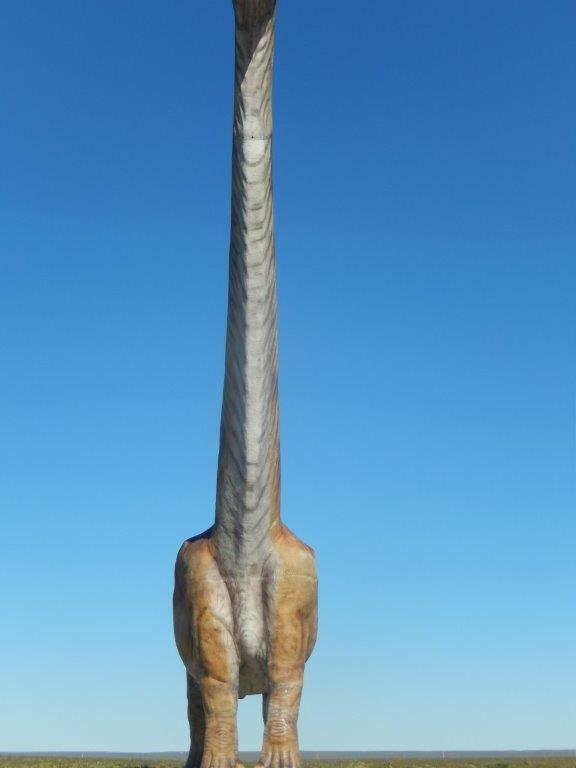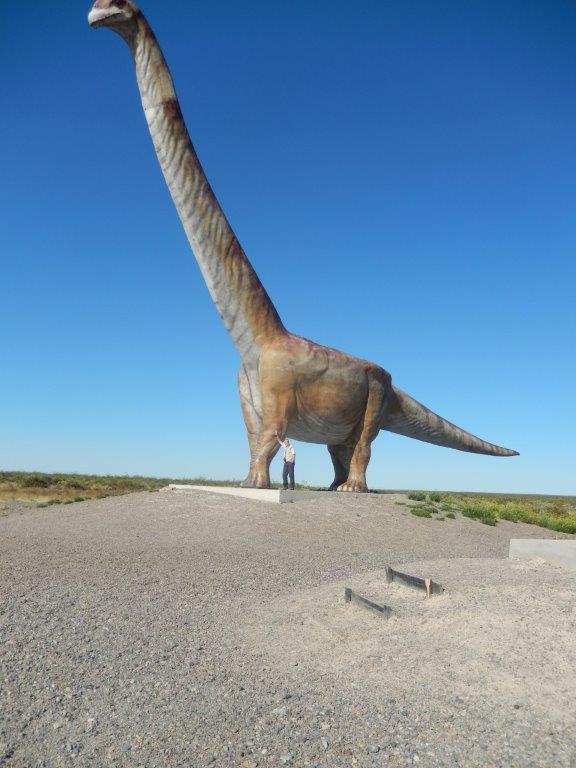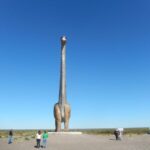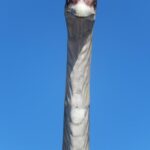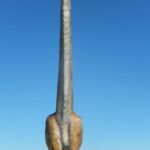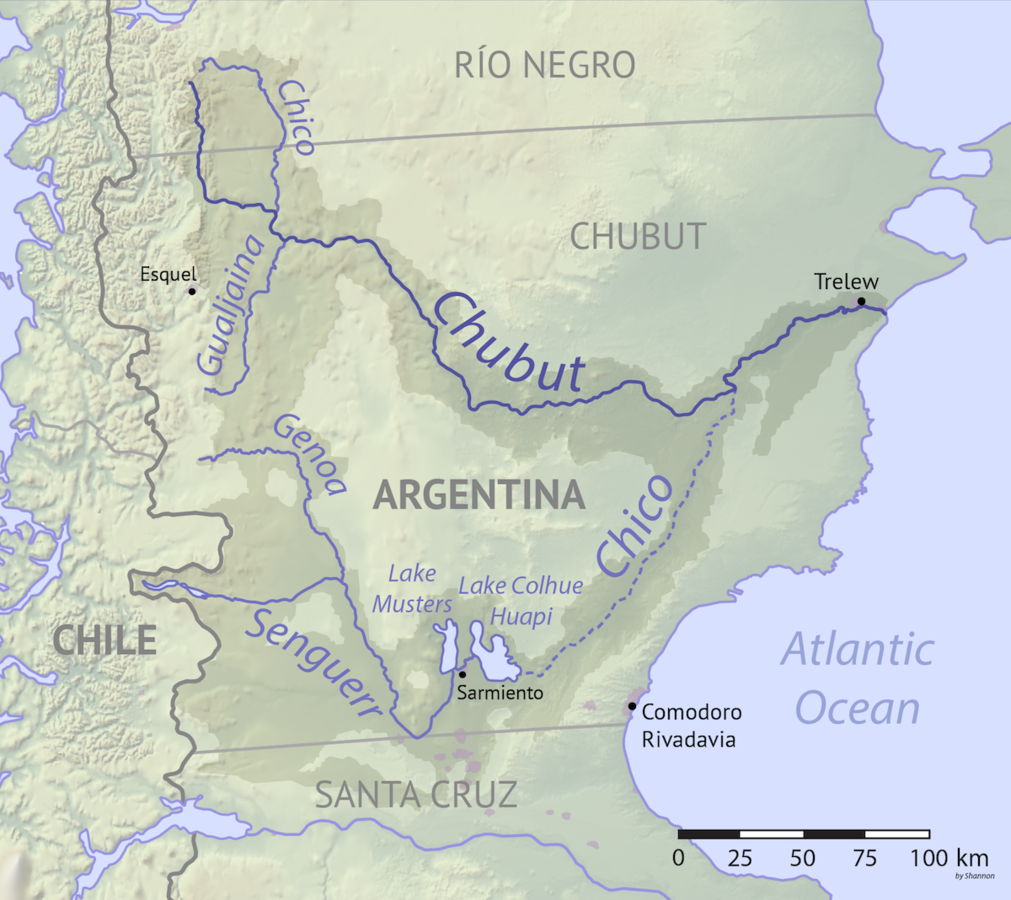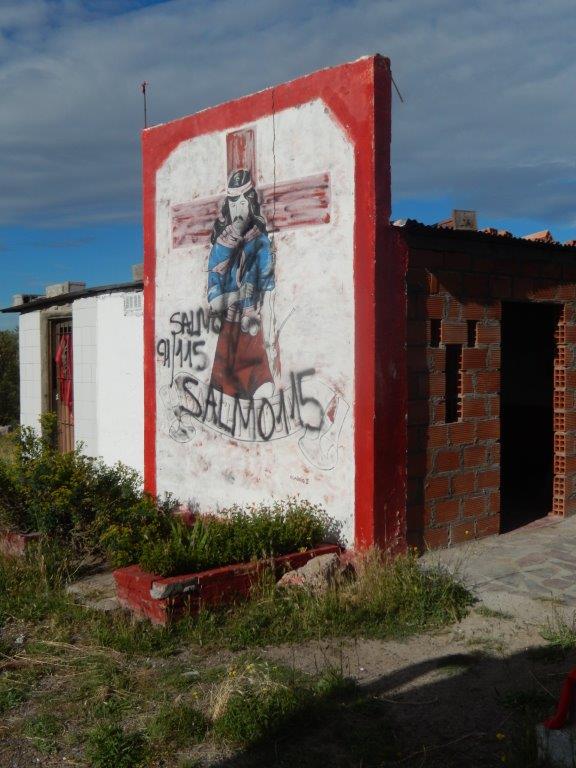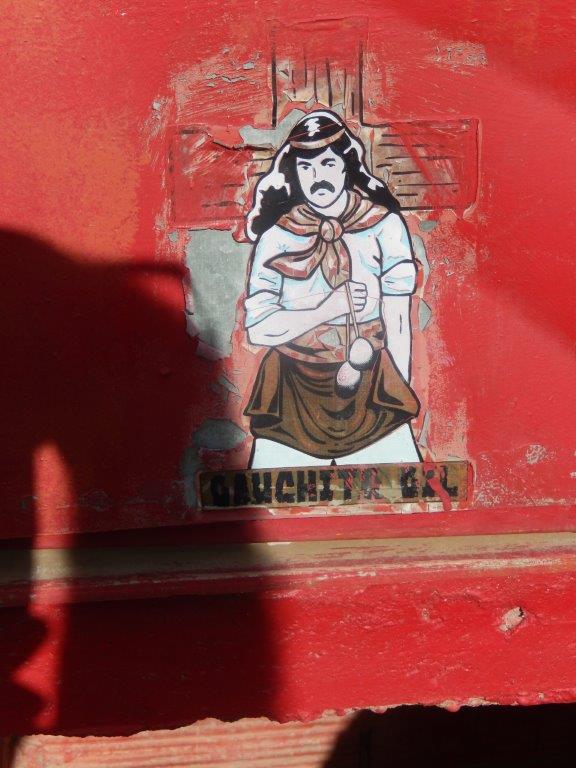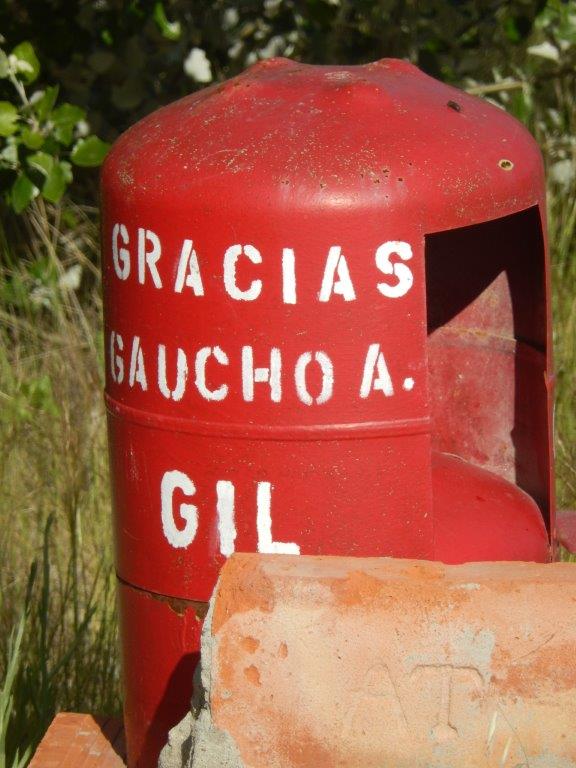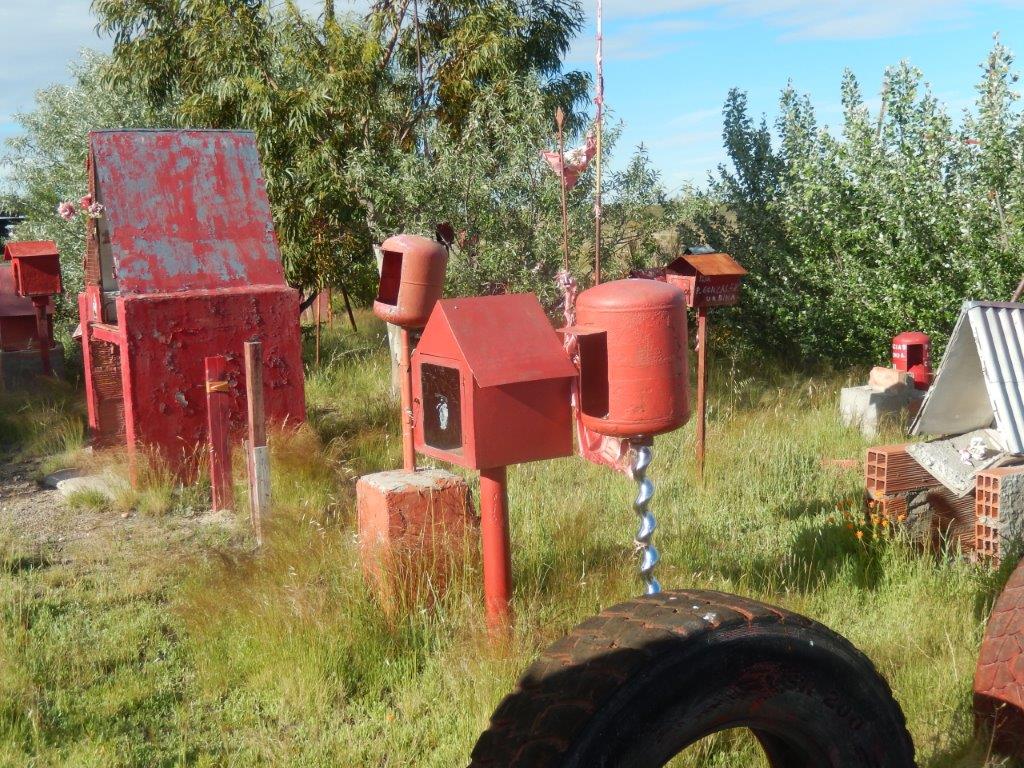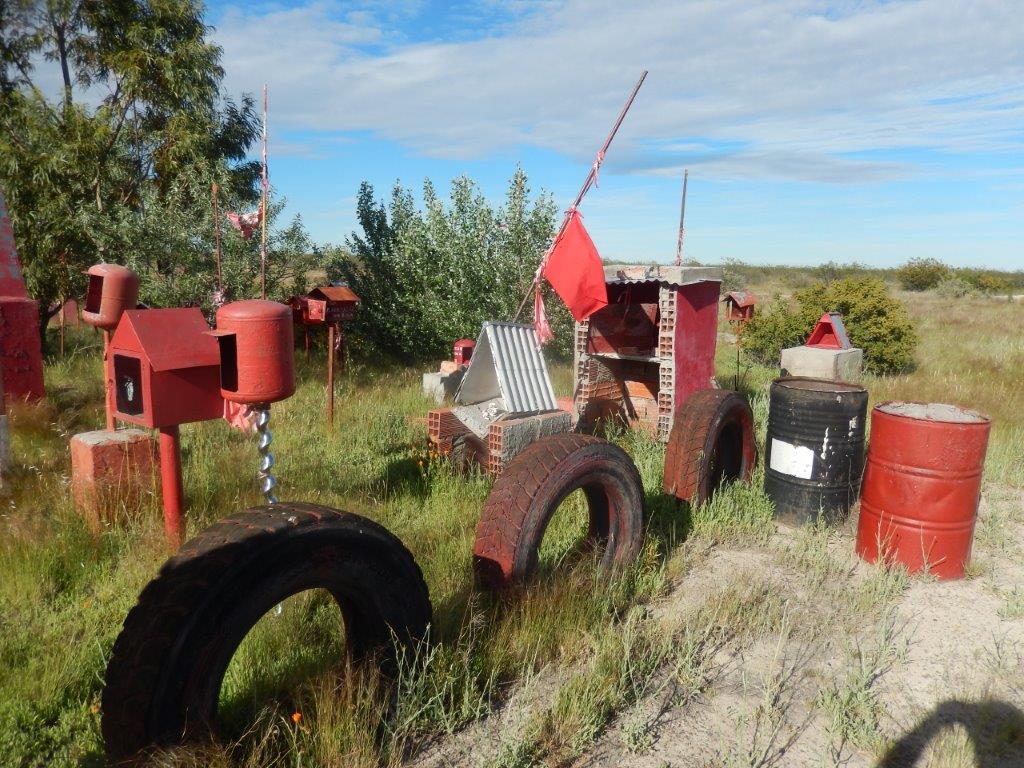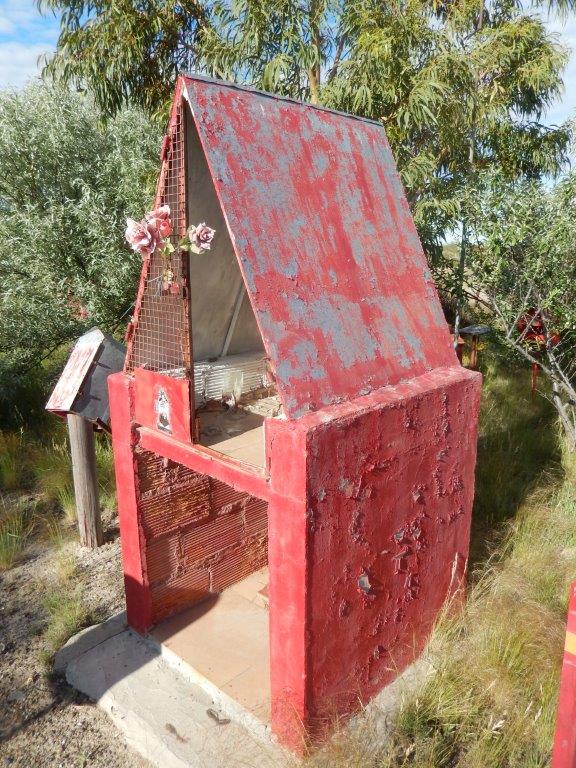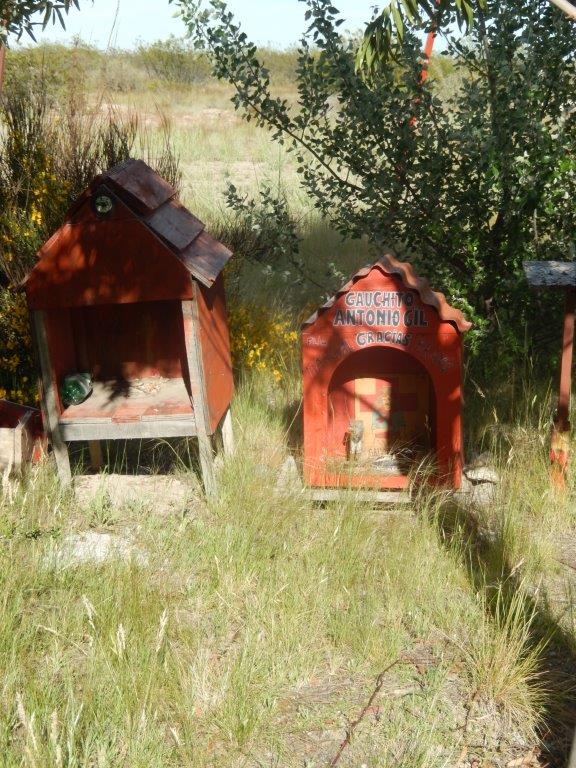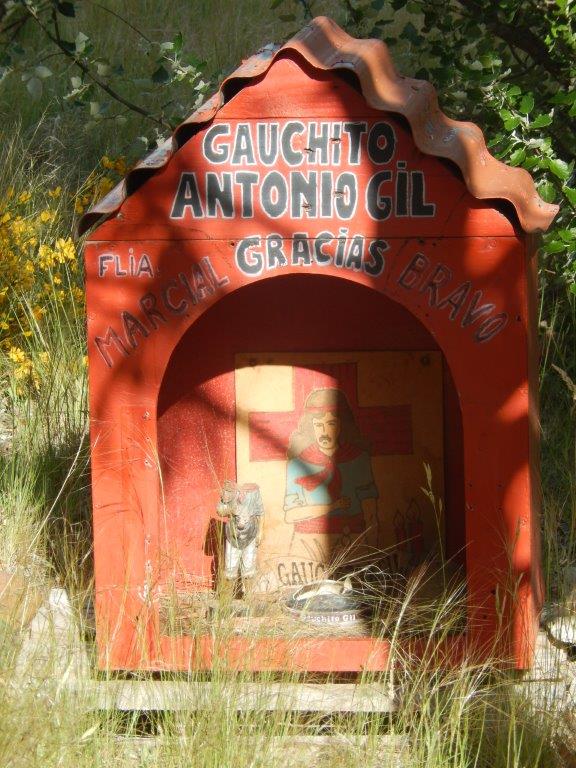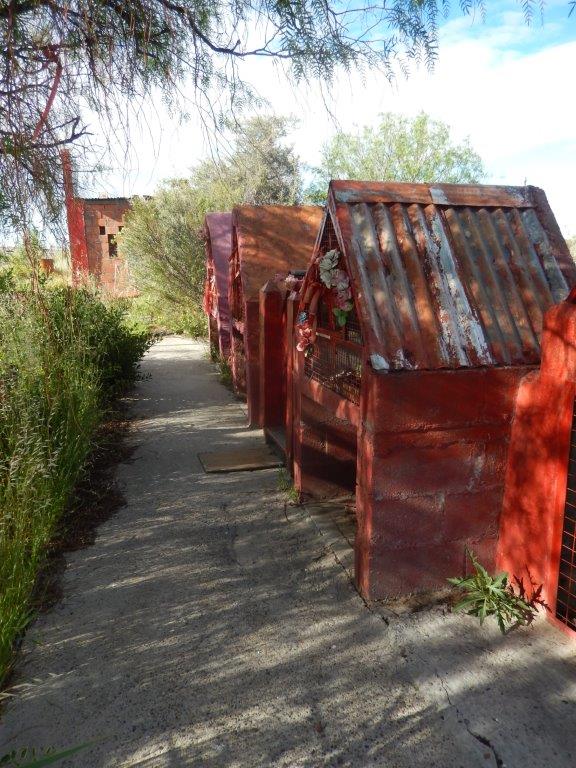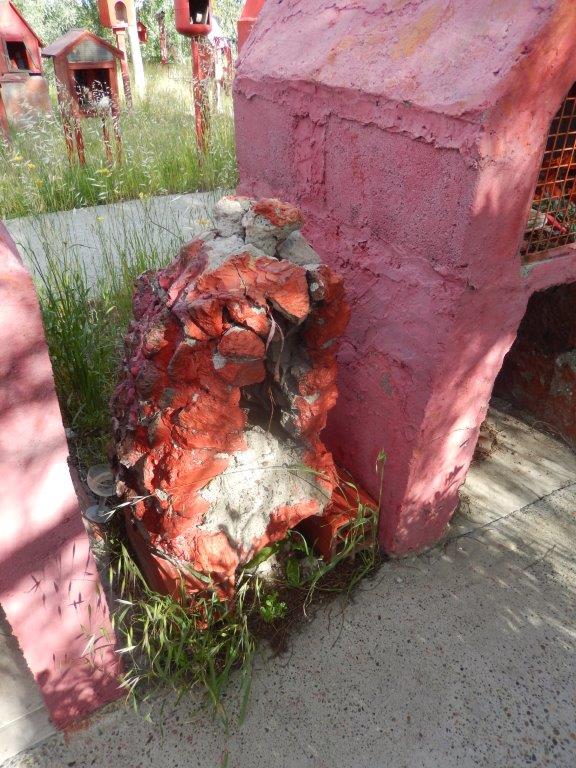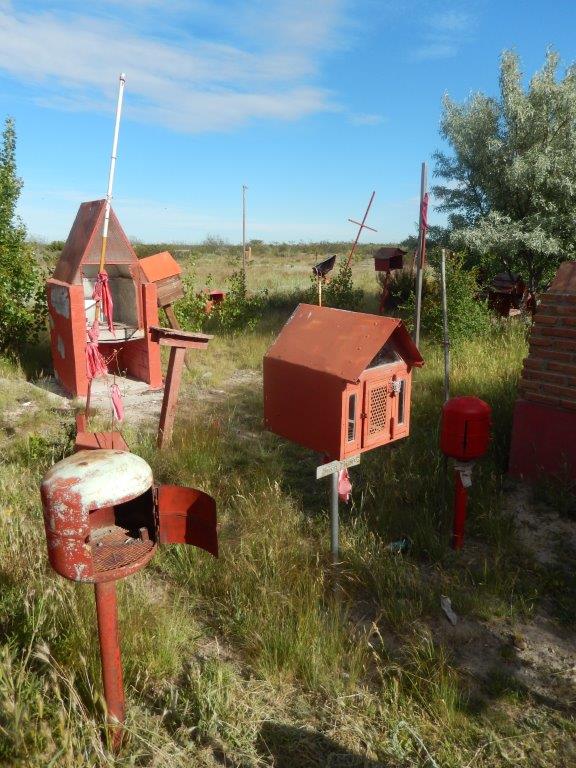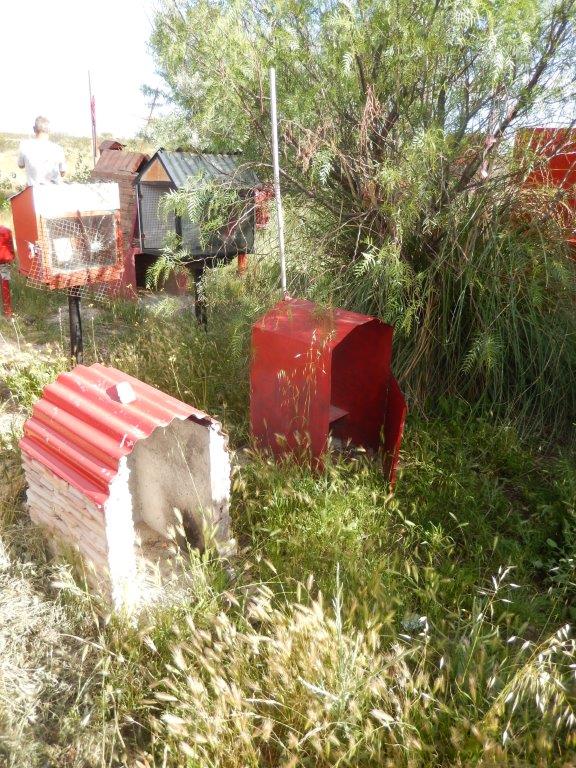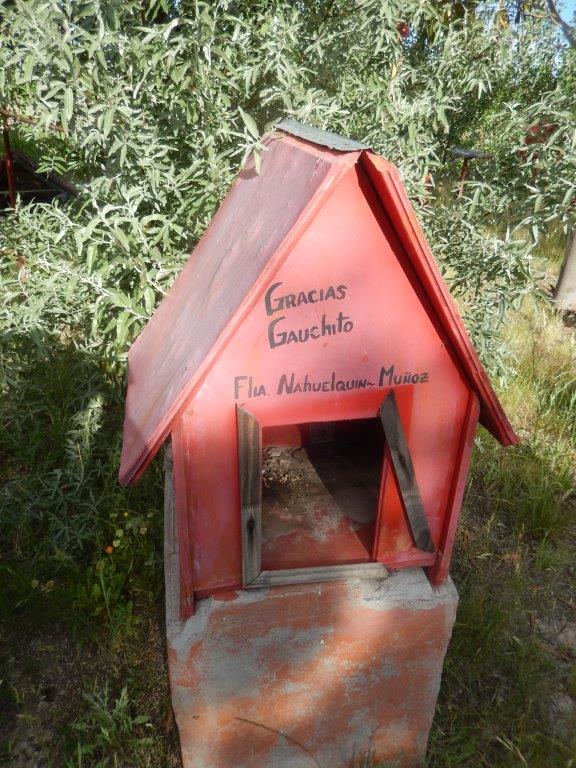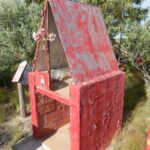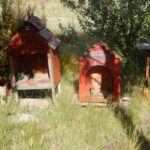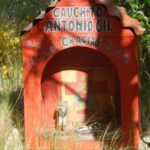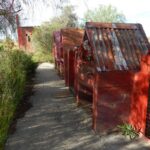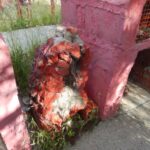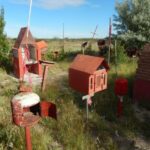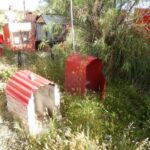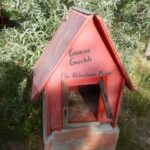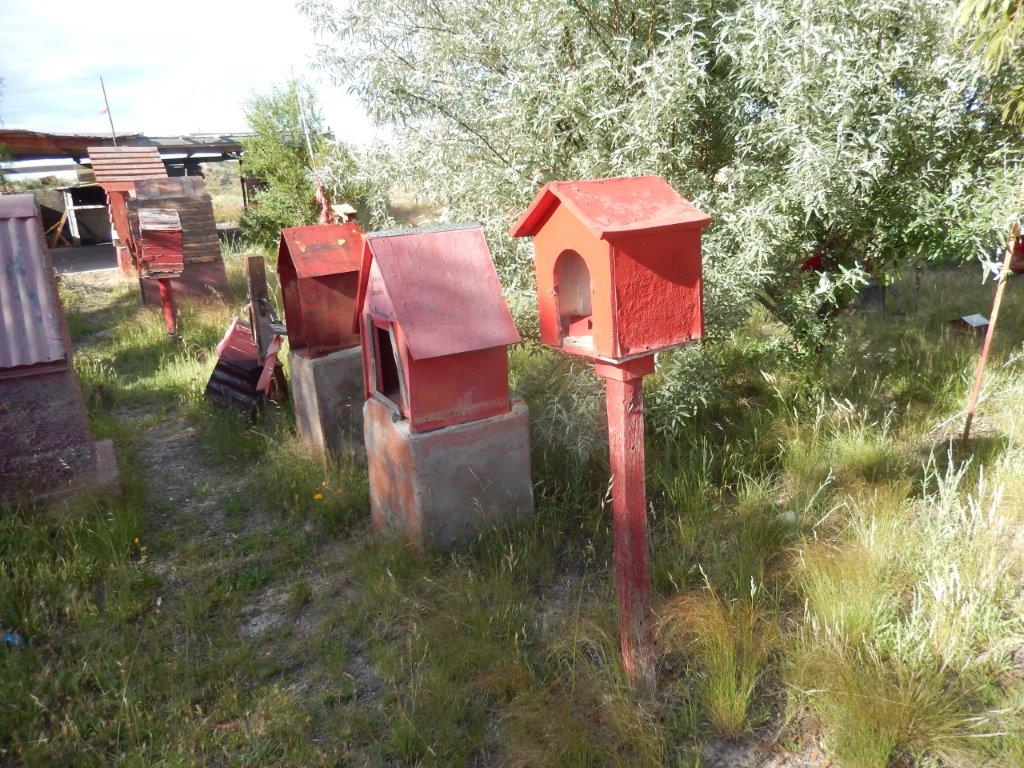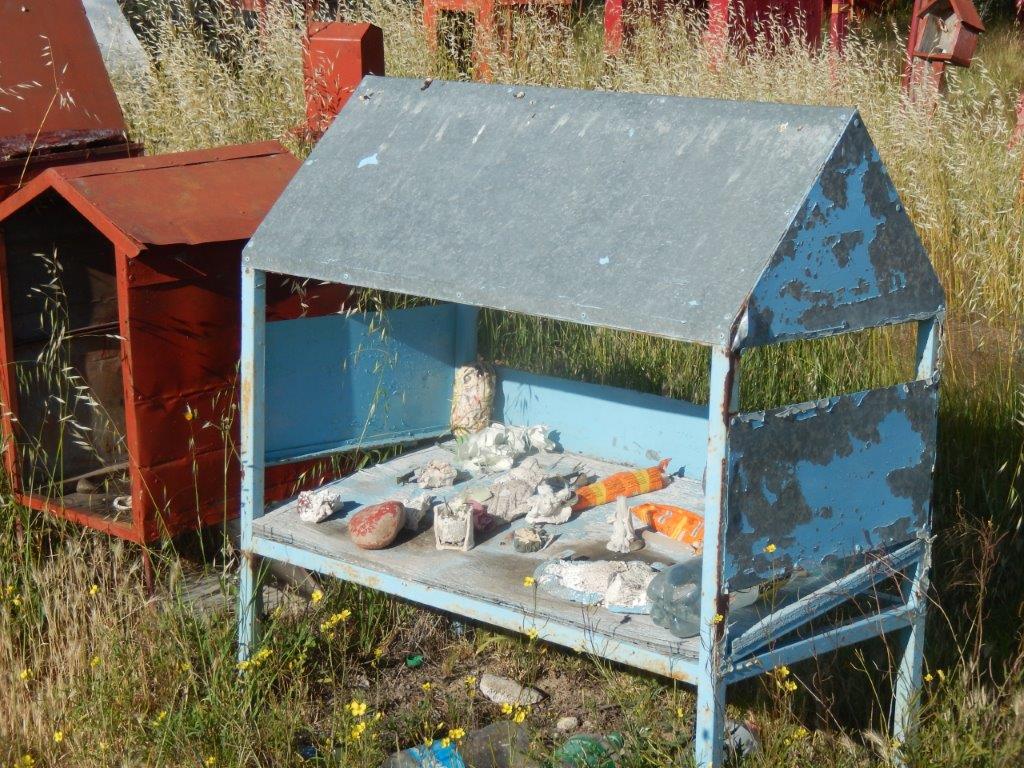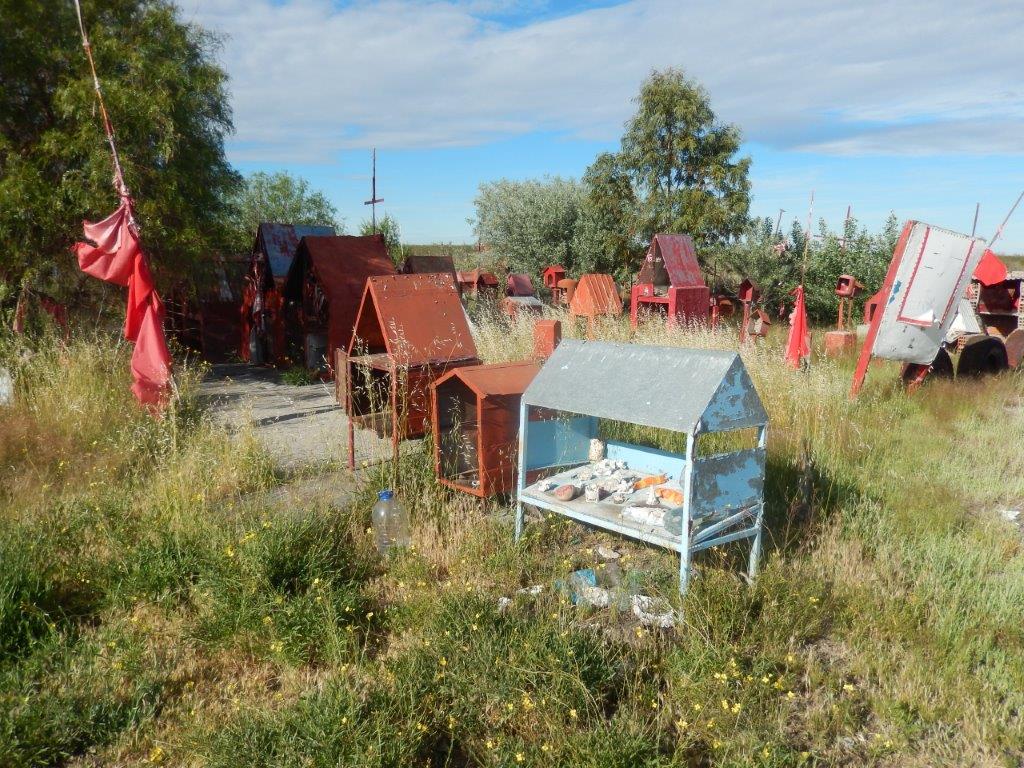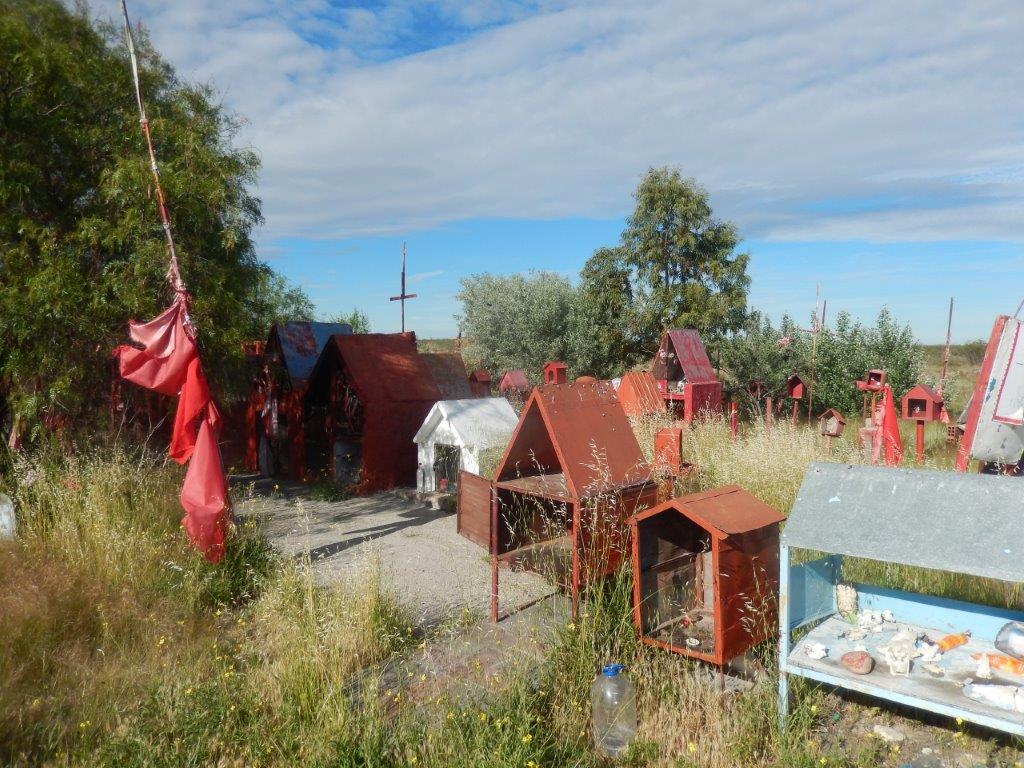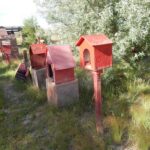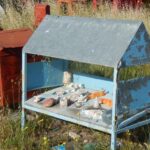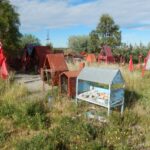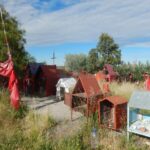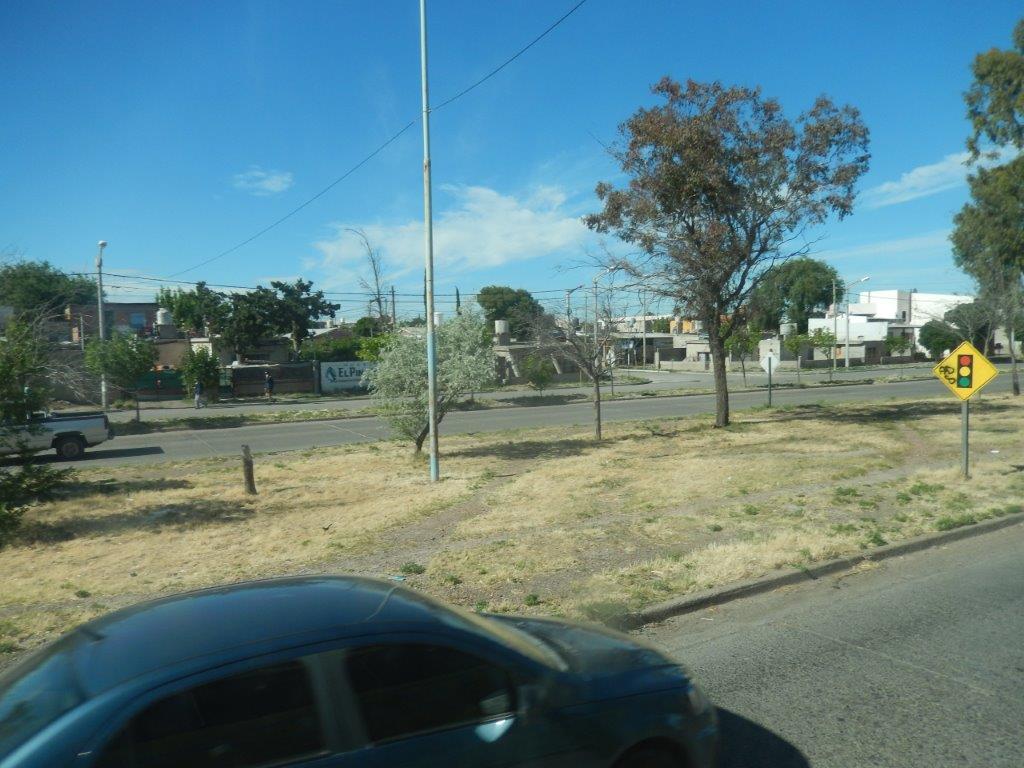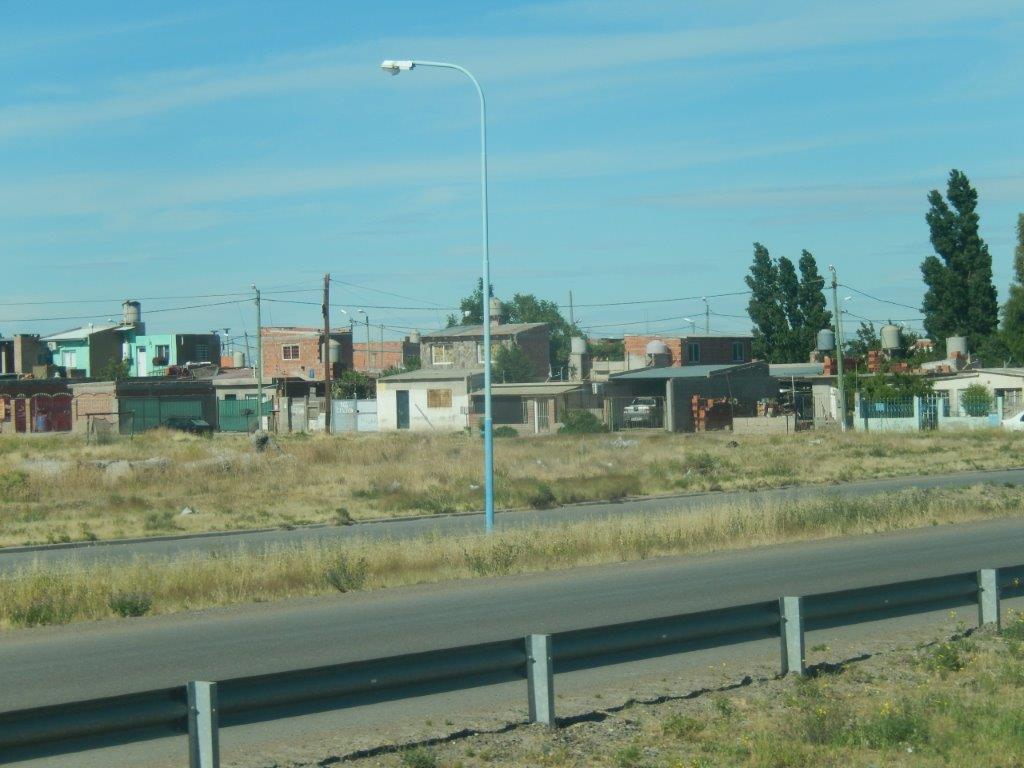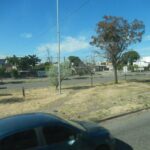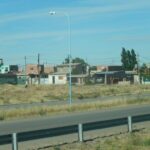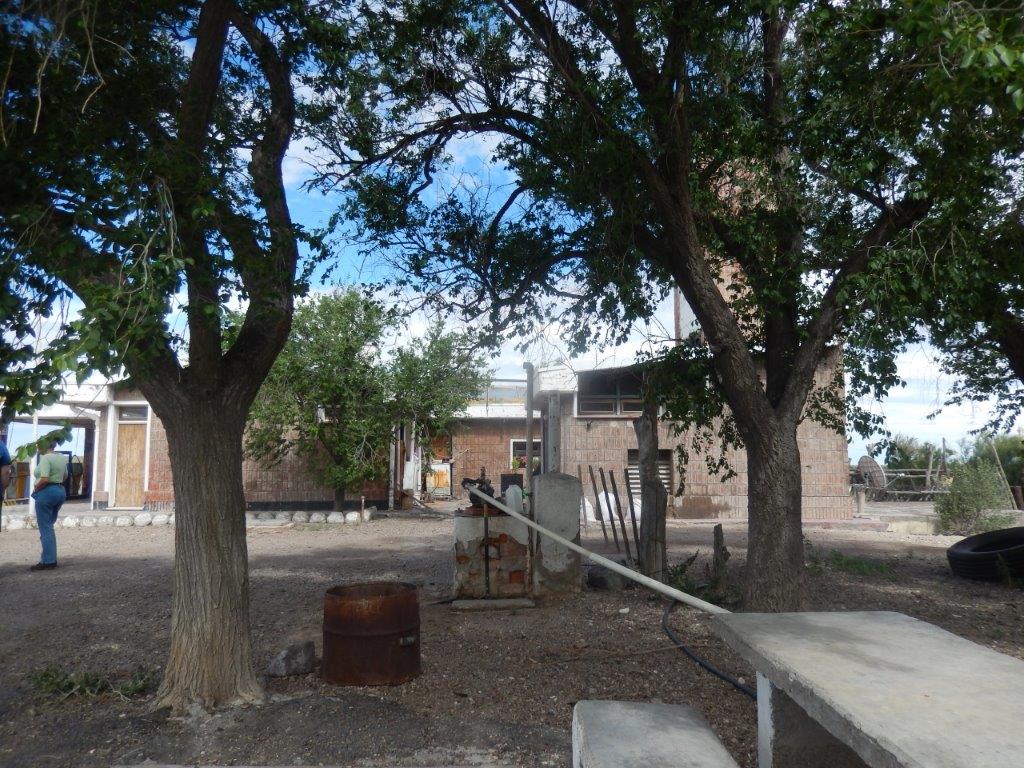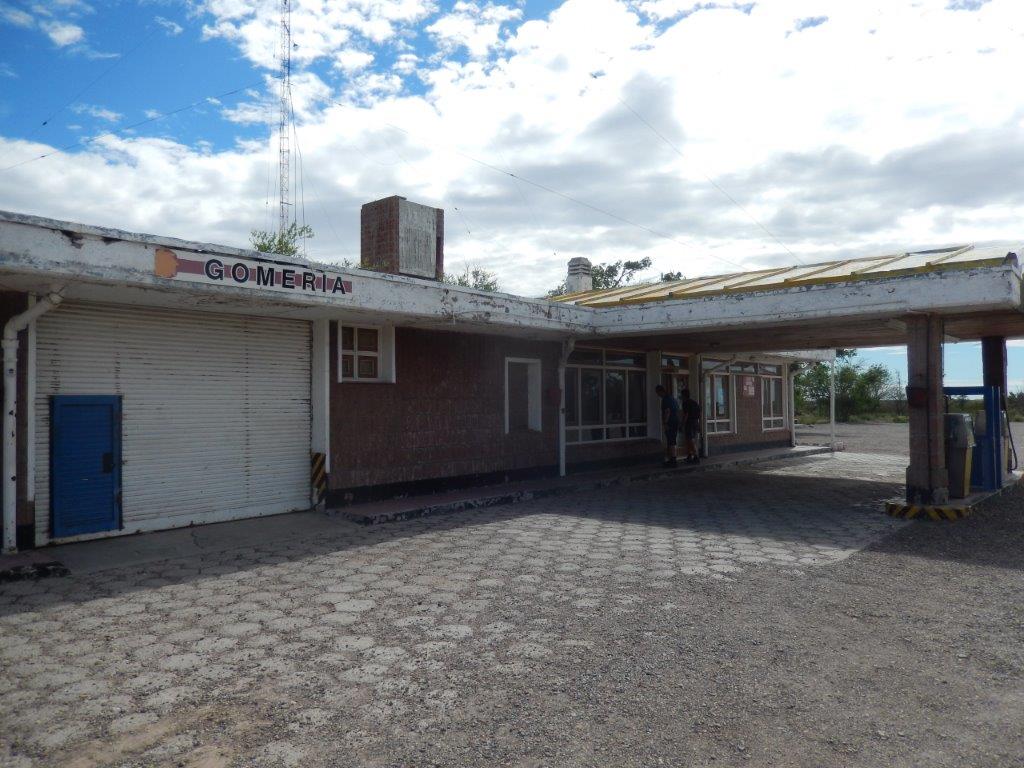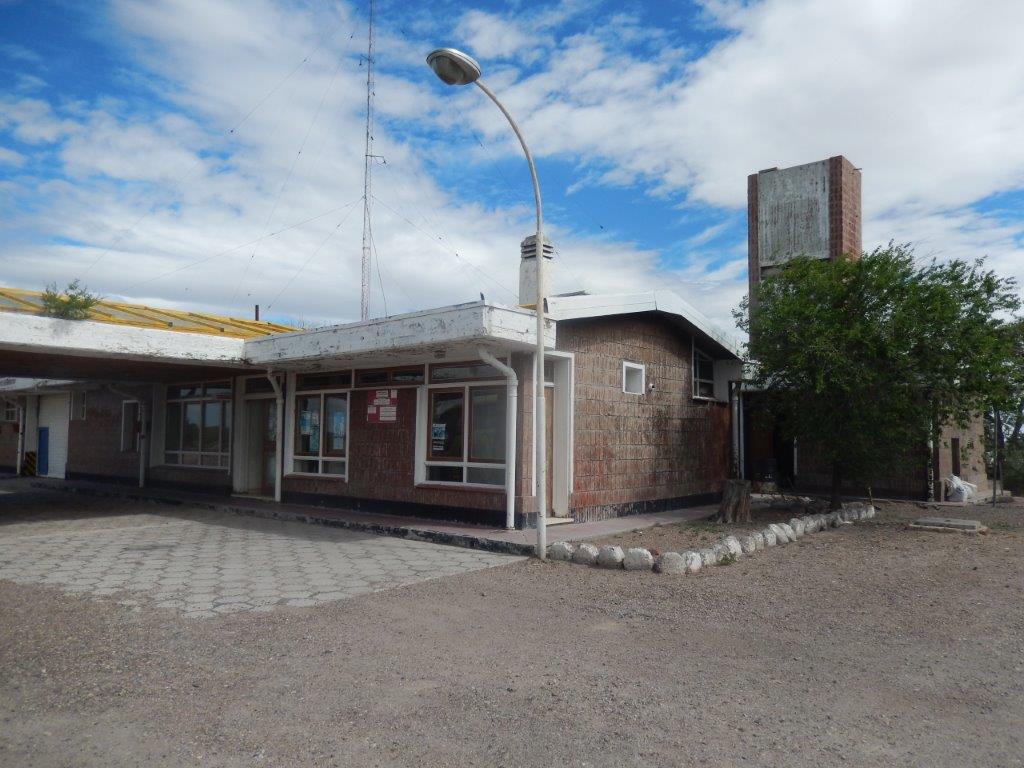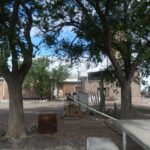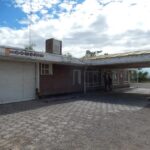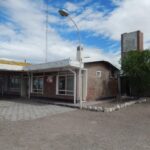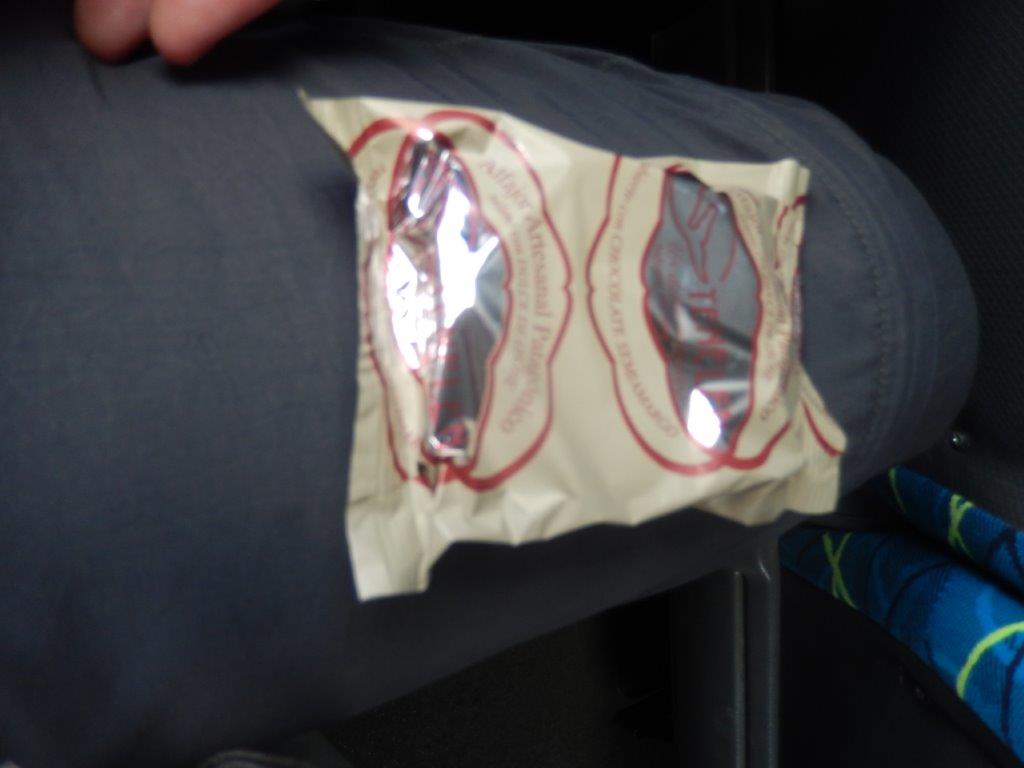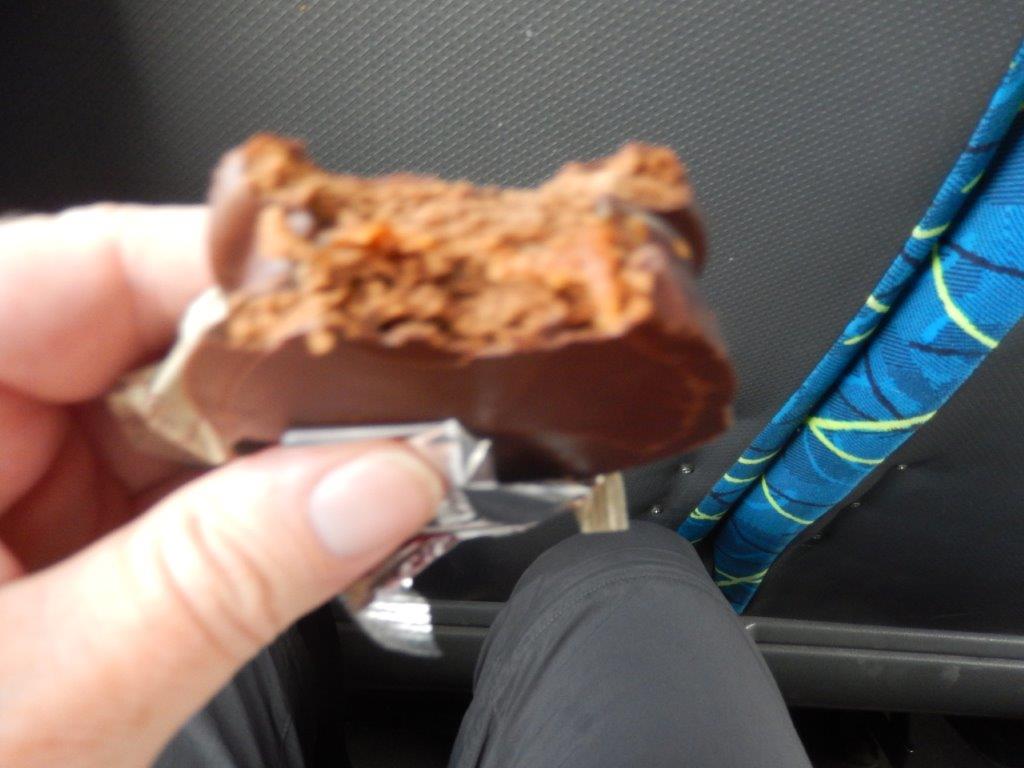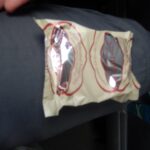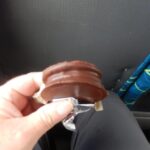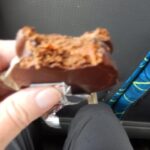9. Argentina: Roadtrip part 1 – Of gigantic Dinosaurs, Welsh Explorers and ruthless Outlaws
After a last view from my breakfast table across the Golfo Nuevo…,
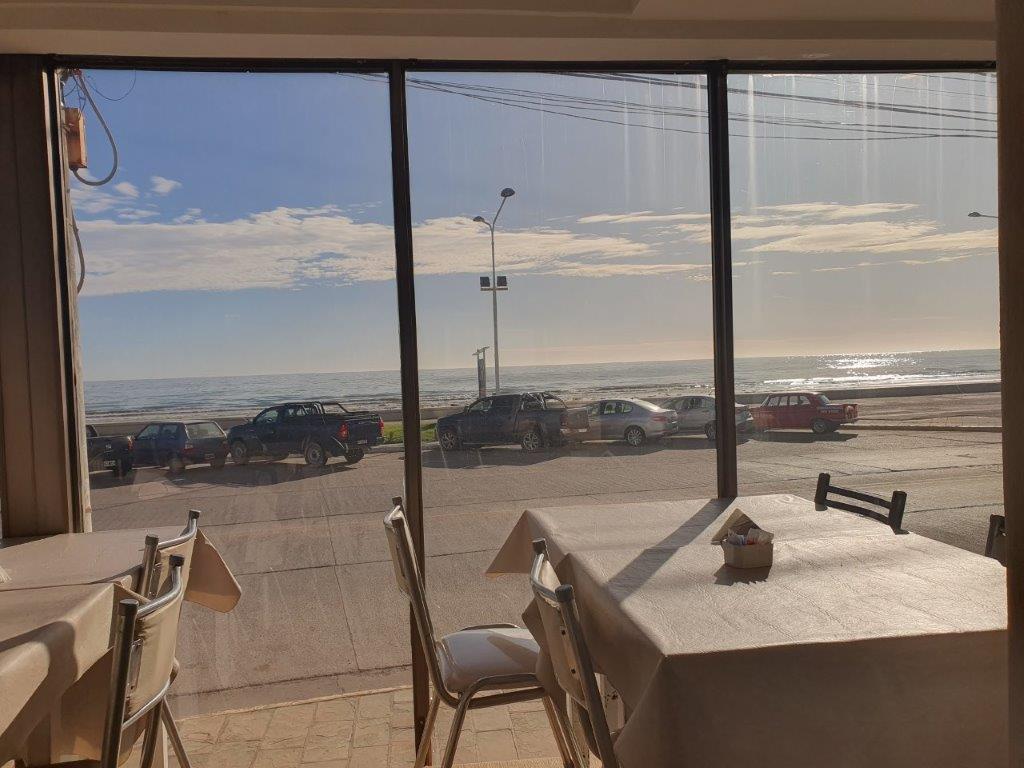 …The Wandelgek was ready to leave the Atlantic East Coast of Patagonia, his head already full of memories. The next stretch of his journey was a roadtrip through Patagonia’s heartland, the Patagonian Plateau also known as The Patagonian Desert or The Patagonian Steppe. It actually was the main landscape feature of Patagonia, including more than 80% of its surface. The Atlantic Coastal area was also part of this Patagonian Desert, but there was a lot more wildlife in the coastal strip because of the influence of the ocean and the all present wind.
…The Wandelgek was ready to leave the Atlantic East Coast of Patagonia, his head already full of memories. The next stretch of his journey was a roadtrip through Patagonia’s heartland, the Patagonian Plateau also known as The Patagonian Desert or The Patagonian Steppe. It actually was the main landscape feature of Patagonia, including more than 80% of its surface. The Atlantic Coastal area was also part of this Patagonian Desert, but there was a lot more wildlife in the coastal strip because of the influence of the ocean and the all present wind.
Wind and sunshine
One defining characteristic of the climate in Chubut province is the strong wind that is observed throughout the province. The wind is an additional factor that makes most of the province dry since it favors evaporation of moisture. Most of the wind comes from either the west, southwest or northwest but in coastal areas during the summer months, a sea breeze can form when westerly winds are weak, forming easterly winds that can penetrate up to 10 kilometres (6.2 mi) from the coast. This is what causes the greener character of the coastal landscape, compared to the much dryer interior of the country. The mean wind speed is 6 metres per second (20 ft/s) with higher wind speeds being recorded in the south where the average is more than 9 metres per second (30 ft/s). Higher altitude areas are more windier than lower altitude areas, resulting in the Andean region being more windier than the coastal areas. Similar to much of Patagonia, summers tend to be windier than winters.
The 1st stretch of the roadtrip went south from Puerto Madryn towards Trelew where the airport was. Just before reaching the airport, The Wandelgek saw a monument of the largest dinosaur that ever existed: The Titanosaur Patagotitan mayorum.
Titanosaur Patagotitan Mayorum monument
Obviously this was a photo moment where The Wandelgek felt the urging need to spend some time next to a humongously large leg of the dinosaur…
Patagotitan is a genus of titanosaurian sauropod dinosaur from the Cerro Barcino Formation in Chubut Province, Patagonia, Argentina. The genus contains a single species known from at least six young adult individuals, Patagotitan mayorum, which was first announced in 2014 and then validly named in 2017 by José Carballido and colleagues. Preliminary studies and press releases suggested that Patagotitan was the largest known titanosaur and land animal overall, with an estimated length of 37 m (121 ft) and an estimated weight of 69 tonnes (76 short tons). Later research revised the length estimate down to 31 m (102 ft) and weight estimates down to approximately 50–57 tonnes (55–63 short tons), suggesting that Patagotitan was of a similar size to, if not smaller than, its closest relatives Argentinosaurus and Puertasaurus. Still, Patagotitan is one of the most completely-known titanosaurs, and so its interrelationships with other titanosaurs have been relatively consistent in phylogenetic analyses. This led to its use in a re-definition of the group Colossosauria by Carballido and colleagues in 2022.
Like Argentinosaurus and other members of the Lognkosauria, Patagotitan was a particularly large and robust titanosaur. It can be distinguished from its close relatives by a suite of unique characteristics in its back and tail vertebrae, scapulae and humeri in the forelimb, and ischia and femora in the hindlimb. Among these was the presence of accessory vertebral articulations known as the hyposphene-hypantrum articulations between only one pair of vertebrae at the level of the scapular blade, which was likely a weight-bearing adaptation not seen in any other sauropod (where they were either present between all pairs or between none). Several unique features in the limbs were also likely attachment scars for muscles. In life, Patagotitan lived in a forested region on a floodplain that was dominated by coniferous trees.
At the airport is a museum where more dinosaur models are exibited. But The Wandelgek skipped the museum because he had a long ride to his destination ahead. A long ride through what once had been Dinosaur country…
The Welsh colonies in the Chubut Valley
The Chubut (Welsh: Talaith Chubut) province, where The Wandelgek had started his travels through Patagonia and where he was now driving through from East to West, is a province in southern Argentina, situated between the 42nd parallel south (the border with Río Negro Province), the 46th parallel south (bordering Santa Cruz Province), the Andes range to the west, and the Atlantic ocean to the east. The province’s name derives from the Tehuelche word chupat, meaning “transparent,” their description of the Chubut River.
The largest city is Comodoro Rivadavia in the south of the province; it has 180,000 inhabitants. The administrative capital is Rawson (40,000). Other important cities are Puerto Madryn, Trelew, Esquel and Sarmiento. Gaiman is a cultural and demographic centre of the region known as “Y Wladfa” in which Welsh-Argentines are concentrated. Of the 25,000 Welsh speakers in Argentina, 5,000 live in the Chubut region, particularly in the early Welsh settlements of Gaiman, Trelew and Trevelin.
Through this desolate area of dry wasteland, the Chubut river is the only river containing a constant water flow throughout the year.
The Chubut River
The Chubut River (Welsh: Afon Camwy) is located in the Patagonia region of southern Argentina. The Argentine Chubut Province, through which the river flows, is named after it. Welsh settlers called the river “Afon Camwy“, meaning “twisting river”.
The river is generally shallow and its water flow can vary from 4 to 400 cubic metres per second (140 to 14,130 cu ft/s) between drought and flood. Average discharge is about 60 cubic metres per second (2,100 cu ft/s).
Flooding made the lands beside the river fertile and important for agriculture. The river has great importance for the agricultural and general economy of the province. There were several attempts to create dams near the two townships of Rawson and Gaiman. The Chubut River has a very rare characteristic being higher than the land around it which is mostly arid. Wheat farming was the chief crop and mainstay of the agricultural and commercial resources of Patagonia. At this time the settlers were struggling with finance as they were using sterling, which was in very short supply.
Wheat and barley became a more readily available material to trade with. The control of water for irrigation became even more important to newly arriving settlers who were allocated parcels of land or “chacras” issued by the Argentine government in the lower part of the valley. In 1882, following a very bad harvest in 1881, a scheme of irrigation ditches from a new canal would ensure consistent watering of crops and deal with the vagaries of the flow of the Chubut. This was key to the survival of the whole Chubut valley.
The construction of the canal and irrigation system was overseen by a young Welshman, E. J. Williams. His meticulous planning created a detailed system of ditches and channels according to an agreed size and fee structure with the settlers. These landowners dug the channels themselves with simple tools.
The river is also a popular trout fishing destination.
Welsh settler colonies
In the 19th century, Welsh settlers arrived in Chubut and established the colony Y Wladfa (Spanish:Colonia Gales) in the valley of the Chubut river. Today, the Welsh language and Welsh tea houses are common in several towns, many of which have Welsh names. Dolavon and Trelew are examples of Welsh towns.
The town of Trelew, which was built later than Gaiman and Dolovan, profited from experiences of the other towns with the devastating floods of the river Chubut. It was built a bit further from the river and thus became a larger town.
Welsh settlers also went on an expedition along the Chubut river valley towards the west, across the Patagonian Desert and stopping at the Andes mountains. Here they created new colonies like Trevelin and Esquel. Esquel was the destination for The Wandelgek’s travels of today too.
Butch Cassidy and Trelew
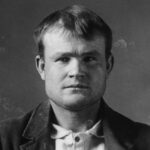 Trelew was used by Butch Cassidy, the notorious bank & train robber, who used it as a hideout, trying to escape the Pinkerton detectives who persistent as blood hounds followed his trail. He hid in the Touring Hotel in central Trelew, which was near to the National Bank. He never robbed this location but instead robbed the National Bank at Mercedes, much more north. I’ll write more about Butch Cassidy and his friend Harry Longabaugh (also known as The Sundance Kid) in upcoming blogposts, because they spend quite some time in Argentina. Beneath is a picture of the National Bank in Trelew..
Trelew was used by Butch Cassidy, the notorious bank & train robber, who used it as a hideout, trying to escape the Pinkerton detectives who persistent as blood hounds followed his trail. He hid in the Touring Hotel in central Trelew, which was near to the National Bank. He never robbed this location but instead robbed the National Bank at Mercedes, much more north. I’ll write more about Butch Cassidy and his friend Harry Longabaugh (also known as The Sundance Kid) in upcoming blogposts, because they spend quite some time in Argentina. Beneath is a picture of the National Bank in Trelew..
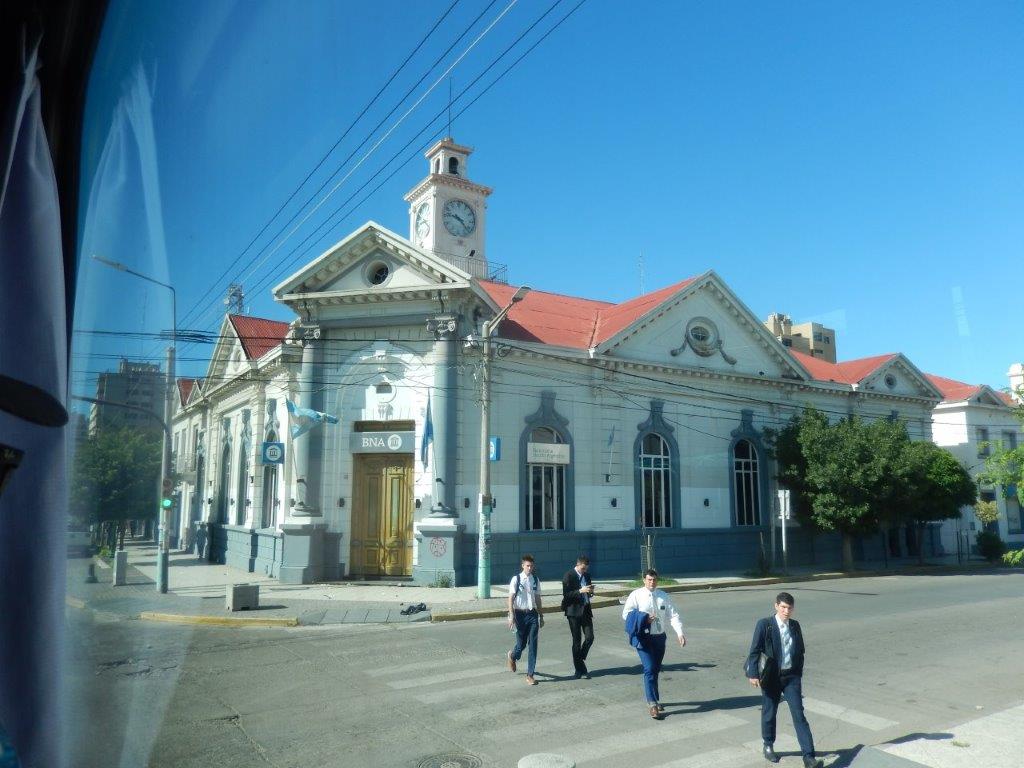 After leaving Trelew, The Wandelgek drove west towards Gaiman.
After leaving Trelew, The Wandelgek drove west towards Gaiman.
Somehow the wild lands of Patagonia had always been drawing and attracting people from all directions. Italians, Spanish, American, Welsh, Swiss and German colonists came to live in these wide open or mountainous lands which were scarcely populated because it was very difficult to make a livin’ here. The fresh Argentine government was glad to facilitate the newcomers with land, because it was still afraid of being reconquered after declaring its independance from Spain. An empty country is easy to conquer, but a country with settlers who had something to loose and thus to fight for, was not an easy target for former colonist Spain. So the Argentine government saw to it that these settlers succeeded and became succesful.
This attracted other newcomers like the earlier mentioned Butch Cassidy and his companion The Sundance Kid. but there were more bandits roaming the country and one of those became really famous, but not in the obvious way…
The legend of outlaw Gauchito Gil
The Gauchito Gil (literally “Little Gaucho Gil”) is a folk religious figure of Argentina’s popular culture. Allegedly born in the area of Pay Ubre, nowadays Mercedes, Corrientes, possibly in the 1840s, and died on 8 January 1878. He is regarded as the most prominent folk hero in Argentina, with smaller areas of veneration reported in Paraguay, Chile and Brazil.
Popular accounts vary, but in broad terms, the legend tells that Antonio Gil was born in the 1840s somewhere in rural Argentina. He was poor and joined or was conscripted into the army during the Triple Alliance War but soon deserted.
The legend is more specific in how/why he got enlisted into the army. He was of poor origin, but got into a serious relationship with the daughter of a very wealthy woman. This wealthy woman did not like her daughters relationship with poor Antonio Gil, thinking he was after her money instead of after her daughter. She could pay rufians to discourage him from seeing her daughter and he subsequently fled into the army. He was in the army, but he refused to be in a war and thus deserted.
After escaping military service a first time, he was forcibly recruited to fight again in the Argentine Civil War but again managed to evade service and became an outlaw. In the years following his desertion, he acquired a reputation as a Robin Hood figure nick named Gauchito.
The government and the army however tried to track him down and eventually a soldier succeeded and had him at gun point, ready for the kill.
Antonio Gil however did something unexpected. He did not try to flee, to draw a gun, to fight. He not even pleed for mercy. Instead he slowly turned around and faced his captivator and possible killer and told him to pray to him after he died, because he would make sure his sick son would soon fully recover from a deadly disease.
Then the soldier killed Gauchito.
The soldier actually started praying to Gauchito asking him to heal his son and his son did fully recover. This was regarded as a miracle.
The soldier subsequently built a small shrine for Gauchito and painted it red…
More and more people hearing about the miraculous recovery of the sick son, started to pray and ask for miracles themselves and many of those requests were fullfilled. These people started to built their own red painted shrines, where they offered all sorts of stuff like cigarettes, alcohol.
Nowadays Gauchito Gil is thought to be a folk saint by many people of the Argentine provinces of Formosa, Corrientes, Chaco, the north of Santa Fe and even the province of Buenos Aires. One can spot smaller shrines of Gauchito Gil on roadsides throughout Argentina due to the red color and the flags, many of which read “Thanks, Gauchito Gil” if the person’s request is fulfilled. The Sanctuary of Gauchito Gil (located about 8 km from the city of Mercedes) organizes great pilgrimages, to which more than 200,000 pilgrims annually head to the sanctuary to ask the saint for favors. The Sanctuary has a mausoleum which holds the actual tomb of Gauchito Gil; plaques adorn the walls and state the names of those whose requests were granted by the saint.
Moreover, each January 8 (date of Gil’s death and his feast day), there is a large celebration honoring Gauchito Gil. Many pilgrims arrive and participate in festive activities, such as drinking, dancing, folklorical animal sports, and a procession that begins from the church in Mercedes to the Sanctuary. Paraphernalia related to the saint, including ribbons, rosaries, flags and statues, are often carried by the pilgrims and sold by vendors. Gauchito Gil statues are commonly seen next to images of San La Muerte, Our Lady of Luján and other Catholic figures.
Gauchito Gil is not recognized as a saint by the Catholic Church, though many Argentines, both devotees and church leaders, have been promoting him for canonization. Local church leaders in Mercedes hold masses on his feast day in the Church of Our Lady of Mercy. Other church leaders in Argentina have participated and approved of the devotion of Gauchito Gil, while some are divided on whether to embrace or condemn the phenomenon. The Diocese of Goya and the Mexican Diocese of Celaya have both recognized the veneration of Gauchito Gil.
After The Wandelgek’s visit to such a collection of Gauchito Gil shrines, he ventured on towards the next little Welsh colony of Gaiman.
Gaiman
Gaiman is a town in the Chubut Province of Patagonia in Argentina. It has a population of 4,730 as per the 2010 census [INDEC]. It is located in the River Chubut’s lower valley (called Dyffryn Camwy in Welsh), about 15 kilometres (9 mi) west of Trelew. Gaiman is a cultural and demographic centre of the main region of the Welsh settlement in Argentina, known in Welsh as Y Wladfa Gymreig.
To The Wandelgek, the gas station at Gaiman was like scene from a Wim Wenders movie, more specificly Paris Texas.
He stopped at a gas station to have a coffee cortado (which tastes most like a cappuccino, even more than… a cappuccino).
Cortado
A cortado is a beverage consisting of espresso mixed with a roughly equal amount of warm milk to reduce the acidity. The milk in a cortado is steamed, but not frothy and “texturized” as in many Italian coffee drinks. The cortado comes from Spain, most likely Madrid, where it is commonly served. It is the most popular coffee drink in Argentina and The Wandelgek could easily guess why.
Alfajor
A popular and delicious bite to accompany a cortado is an Alfajor. An alfajor or alajú is a traditional confection typically made of flour, honey, and nuts. It can be covered in chocolate. It is found in Paraguay, Argentina, the Philippines, Southern Brazil, Southern France, Spain, Uruguay, Peru, Ecuador, Colombia and Chile. The archetypal alfajor entered Iberia during the period of al-Andalus. It is produced in the form of a small cylinder and is sold either individually or in boxes containing several pieces.
Then The Wandelgek proceeded towards:
Dolovan
Dolovan was the last stop in the civilized world before really entering the wilderness of the vast but marooned Patagonian Desert.
More of that in part 2: Crossing the Patagonian Desert in the wake of Welsh explorers

